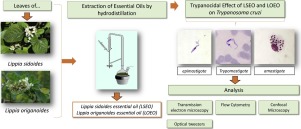Micron ( IF 2.5 ) Pub Date : 2019-11-12 , DOI: 10.1016/j.micron.2019.102781 Andrezza Raposo Borges de Melo 1 , Taciana Mirely Maciel Higino 1 , Aline Dulce Pitt da Rocha Oliveira 2 , Adriana Fontes 2 , Diego César Nunes da Silva 3 , Maria Carolina Accioly Brelaz de Castro 4 , José Arimatéia Dantas Lopes 5 , Regina Celia Bressan Queiroz de Figueiredo 1

|
Chagas disease, caused by the protozoan Trypanosoma cruzi, is considered a public health problem. The current chemotherapy for this illness causes serious side effects and its use in the chronic phase of the disease is still controversial. In this regard, the investigation of novel therapeutic strategies remains a priority. The essential oils (EOs) from aromatic plants emerge as a promising source of bioactive compounds. In a previous work we reported the trypanocidal activity of the essential oils from the medicinal plants Lippia sidoides (LSEO) and Lippia origanoides (LOEO) against T. cruzi. Herein, we aimed to further investigate, in more details, the mode of action of LSEO and LOEO on the different developmental stages of this parasite. We showed that Lippia sidoides (LSEO) and Lippia origanoides (LOEO) induced a significant reduction in the percentage of macrophages infected by T. cruzi and in the number of intracellular parasites. Ultrastructural analysis showed that the treatment with both oils caused morphological changes consistent with loss of viability and cell death. The reduced staining with calcein and the increase in the proportion of HE–positive cells also demonstrated that LSEO and LOEO caused loss of parasite viability and membrane integrity. A considerable decrease in Rhodamine 123 and an increase in fluorescence intensity of MitoSox in LOEO were indicative of loss of mitochondrial potential and generation of reactive oxygen species, which ultimately lead to parasite death. Moreover, the optical tweezer analysis indicated that LOEO was more effective in reducing the motility of the epimastigotes. Taken together, our results demonstrated that the LSEO and LOEO are active against T. cruzi and constitute a promising drugs for the therapy of Chagas disease.
中文翻译:

Lippia sidoides和Lippia origanoides精油会影响克氏锥虫的生存力,运动性和超微结构。
由原生动物克氏锥虫引起的南美锥虫病被认为是公共卫生问题。当前用于该疾病的化学疗法引起严重的副作用,并且在该疾病的慢性期中的使用仍然是有争议的。在这方面,研究新的治疗策略仍然是优先事项。来自芳香植物的精油(EOs)成为有前途的生物活性化合物来源。在先前的工作中,我们报道了药用植物小榄仁(LSEO)和小榄仁(LOEO)的精油对克鲁氏锥虫的锥虫杀虫活性。。在本文中,我们旨在更详细地研究LSEO和LOEO在该寄生虫不同发育阶段的作用方式。我们表明,Lippia sidoides(LSEO)和Lippia origanoides(LOEO)诱导了被克鲁氏锥虫感染的巨噬细胞百分比显着降低。和细胞内寄生虫的数量。超微结构分析表明,两种油的处理均引起与存活力下降和细胞死亡一致的形态变化。钙黄绿素减少的染色和HE阳性细胞比例的增加也表明,LSEO和LOEO导致寄生虫生存力和膜完整性的丧失。罗丹明123的大量减少和LOEO中MitoSox荧光强度的增加表明线粒体电位的丧失和活性氧的产生,最终导致寄生虫死亡。此外,光学镊子分析表明LOEO在降低副鞭毛者的蠕动方面更有效。两者合计,我们的结果表明,LSEO和LOEO对T. cruzi有活性。 并构成治疗查加斯病的有前途的药物。











































 京公网安备 11010802027423号
京公网安备 11010802027423号